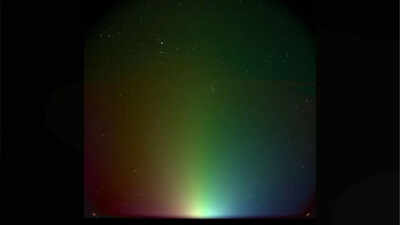ARTICLE AD BOX

NASA’s newest solar research mission is already producing some amazing outcomes. The PUNCH or Polarimeter to Unify the Corona and Heliosphere mission, which was launched on March 12, 2025, is a set of four small satellites working together in low Earth orbit to study the sun’s outer atmosphere and solar wind.
Within weeks of launch, it sent back its first set of images, including a colourful and unusual “rainbow” view of a faint glow caused by sunlight scattering off dust in space that was rare and rarely seen before.These early images are scientific and have quickly caught the attention of space enthusiasts due to their unexpected beauty. One image, taken on April 18 by the WFI-2 instrument, shows a soft gradient of red, green, and blue light against a starry sky.
The image shows how the spacecraft measures different wavelengths of light and the direction that light has been polarised by particles in space.

A rainbow in space
This image isn’t a real rainbow, but a false-colour representation of polarised light from space dust. The colours including red, green, and blue, reflect different polarisation angles that help scientists understand how light scatters off interplanetary particles.
As said by NASA in a SwRI press release, “The image is colorised to show the polarization (or angle) of the zodiacal light, a faint glow from dust orbiting the sun.” These early images help scientists confirm that the instruments are working correctly and are ready for more detailed solar observations.
Seeing the moon in a new light
Another exceptional moment happened on April 27, when one of PUNCH’s cameras, the Narrow Field Imager (NFI), spotted the new moon passing near the sun.
To see this clearly, the NFI used a special cover called an occluder to block out the sun’s bright light. In the image, the moon looks full even though it was technically a new moon. That’s because of something called “Earthshine”, or sunlight bouncing off Earth and lighting up the moon’s dark side.
This helped scientists make sure the moon won’t get in the way of PUNCH’s future views of the sun’s outer layers.

On April 16, two of the other PUNCH satellites, WFI-1 and WFI, also captured the soft glow of zodiacal light.
Through their wide-angle view, they picked up some famous sights in the night sky, like the Hyades and Pleiades star clusters, the Andromeda galaxy, and the Cassiopeia constellation. These early images are helping scientists fine-tune the instruments, but they also show just how sensitive PUNCH is as it can spot even the faintest details way out in space.
SPHEREx joins the ride
Launched alongside PUNCH aboard a SpaceX Falcon 9 rocket from Vandenberg Space Force Base, SPHEREx is another NASA mission with big goals. Unlike the James Webb Space Telescope, which zooms into distant objects, SPHEREx will scan the whole sky in 102 infrared colours. As Nicky Fox, associate administrator for NASA’s Science Mission Directorate, said in a SPHEREx briefing, “We are literally mapping the entire celestial sky in 102 infrared colors for the first time in humanity's history.
”Photo: NASA/ SwRI



.png)
.png)
.png)
















 9 hours ago
5
9 hours ago
5









 English (US) ·
English (US) ·